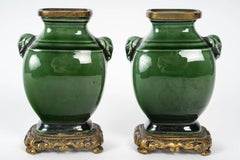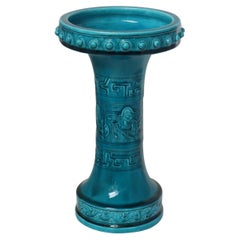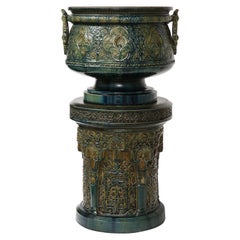Earthenware Vases
1
4
to
3
1
4
4
4
4
Height
to
Width
to
7
4
4
2
2
4
4
9
317
40
33
32
Material: Earthenware
Creator: Theodore Deck
Théodore Deck (1823-1891), Miniature Pair of Faience Vases circa 1870
Located in Saint-Ouen, FR
Theodore Deck (1823-1891)
A deep green enameled faience miniature pair of vases molded in the Chinese Archaistic Taste.
Coves in the shape of elepha...
Category
1870s French Chinoiserie Antique Earthenware Vases
Materials
Faience
Theodore Deck '1823-1891', a Japonisme Polychromed Faience Quadrangular Vase
Located in Saint-Ouen, FR
Theodore Deck (1823-1891)
A Polychromed Faience quadrangular vase, decorated in a cartouche with butterfly and birds on branches of prunus and peonies in the Japanese Taste on a pu...
Category
Late 19th Century French Japonisme Antique Earthenware Vases
Materials
Faience
Pair of Gilt Bronze Mounted Faience Lamps by Deck
Located in London, GB
These beautiful table lamps are by Théodore deck, one of the most important ceramicists of the 19th Century, and Gagneau Frères, a leading bronzier. Deck was the director of a presti...
Category
Late 19th Century French Antique Earthenware Vases
Materials
Ormolu, Bronze
Pair of Ormolu-Mounted Theodore Deck Faience Persian-Blue Vases with Lampshades
Located in Palm Desert, CA
A pair of late 19th century ormolu-mounted faience Persian-blue vases by Theodore Deck, mounted as oil lamps. As in traditional Persian design, the lamps are bottle-shaped, with a wi...
Category
19th Century French Antique Earthenware Vases
Materials
Ormolu
Related Items
Pair of Romantic Yellow Tole Urns Mounted as Lamps
Located in Kittery Point, ME
Each mounted as a lamp, the flaring top above a stepped square base, with a decor of antique scenes and symbols. Electrified. Measures: Height of urns only, 15in.; height overall, 29...
Category
19th Century French Romantic Antique Earthenware Vases
Materials
Tôle
Pair of Large Stunning Burmantofts Faience Floral Vases
Located in Bishop's Stortford, Hertfordshire
A stunning pair of Burmantofts Faience vases of slender baluster form, cast in low relief with flowers and foliage, in shades of blue, turquoise, green, yellow and red on a cream gro...
Category
1880s English Antique Earthenware Vases
Materials
Pottery
19th Century Delft Polychrome Faience Vase
Located in Winter Park, FL
A 19th century delft faience polychrome painted vase with round body and narrow neck ending in an open bulb. Beautifully decorated in blue, orange, brown and green with large medalli...
Category
19th Century Dutch Chinoiserie Antique Earthenware Vases
Materials
Faience
Pair of 19th Century Gilt-Bronze & Faience Porcelain Table Lamp Candelabras
Located in Los Angeles, CA
A fine pair of French 19th-20th century Louis XV style gilt bronze and Faience porcelain three-light candelabra table lamps. The ovoid porcelain urn hand decorated in floral burgundy...
Category
Early 1900s French Louis XV Antique Earthenware Vases
Materials
Ormolu, Bronze
H 32 in W 12 in D 10.75 in
Antique Pair of Chinese Yellow Ground Porcelain Miniature Vases
Located in New York, NY
Lovely pair of miniature Chinese yellow ground porcelain vases with applied plum blossom trees and butterflies. Each Stand on circular rosewood b...
Category
Early 20th Century Chinese Chinoiserie Earthenware Vases
Materials
Porcelain
Francois Theodore Legras Pair of Vases in Enameled Glass Circa 1900
Located in Beuzevillette, FR
This pair of vases is made of glass. They are green in colour with formal motifs in enamel. The flowers remind of hibiscus. They are of an Art Nouveau style.
Art Nouveau is an ar...
Category
Early 20th Century French Art Nouveau Earthenware Vases
Materials
Glass
Petite French Faience Vase Desvres, circa 1900
By Desvres
Located in Austin, TX
Small French faience jardinière with floral pattern Desvres, circa 1900.
Category
Early 1900s French French Provincial Antique Earthenware Vases
Materials
Ceramic, Faience
Antique Japonisme French Baccarat Glass Bronze Vase
By Baccarat
Located in New York, NY
An antique French Baccarat glass vase with a fluted mouth. The vase is adorned with hand painted floral and foliage motifs in the Asian man...
Category
19th Century French Antique Earthenware Vases
Materials
Bronze
French Faience Vase Gien Circa 1890
By Gien
Located in Austin, TX
French Faience Vase Gien Circa 1890.
Asian inspiration.
Decorated with peonies and pheasants.
Category
1890s French French Provincial Antique Earthenware Vases
Materials
Faience
Théodore Deck, Ceramic Vase, Signed, circa 1870
Located in Saint-Ouen, FR
Théodore Deck (1823-1891), ceramic vase, signed, circa 1870.
Category
Late 19th Century French Art Nouveau Antique Earthenware Vases
Materials
Ceramic
Egyptian Blue Faience French Vase, circa 1920
Located in Kensington, MD
This unusual double bulb shaped faience vase is in the manner of Edmond Lachenal but there are no markings on the bottom. The rich mottled turquoise blue glaze gives it the feeling o...
Category
1920s French Art Nouveau Vintage Earthenware Vases
Materials
Faience, Pottery
French Japonisme Ormolu-Mounted Baccarat Crystal Vase with Bronze Turtle Feet
Located in New York, NY
A Gorgeous and extremely rare French Japonisme ormolu-mounted turtle footed Baccarat crystal vase designed with a gilt turtle design, Baccarat stamp on bottom. The quality and craftsmanship of this piece is second to none. Baccarat crystal is known to be the best crystal in the world and this piece appropriately demonstrates that. The crystal vase is seated on four beautifully cast and hand-chiseled ormolu turtles, representing the Japanese artistic movement in France at the time, known as 'Japonisme'. The body of the vase is a gorgeously hand painted with raised gold and enamel decoration of a turtle and various other decorations, making it seem as though the turtle is swimming in a lake. Underneath the turtle are painted rocks and mosses, while above the turtle are cherry trees, dropping their fruit into the water. On the reverse of the main panel are two turtles swimming...
Category
1880s French Japonisme Antique Earthenware Vases
Materials
Crystal, Bronze
Previously Available Items
Theodore Deck (1823-1891) , A Chinese Archaïc Taste Blue Faience Vase circa 1875
Located in Saint-Ouen, FR
A Theodore Deck (1823-1891) Faience Persian blue, " Bleu Deck" Diabolo shape Vase
Moulded in low relief and incised with fretwork and scrolls pattern in the Chinese Archaistic taste,
Impressed Uppercase TH.DECK mark.
circa 1875
Illustrated in "Théodore Deck ou l'éclat des émaux 1823-1891", Exhibition Catalogue held in Musée de Marseille, under # 24 page 54
Born in Guebwiller in Alsace, Théodore Deck trained as a ceramist in his home region, then in Germany. He went into partnership with his brother, Xavier Deck, to create his own factory in Paris in 1858. At the Exhibition of Industrial Arts in 1864, he presented pieces covered with transparent enamels that were not cracked, and then made his first attempts at reliefs under transparent enamels. He developed a bright turquoise color, famously renowned as "Bleu Deck". It is this nuance that we find on the salamander represented on this vase. In 1887 he published a treatise entitled "La Faïence", in which he explained some of his discoveries. That same year, he became director of the Manufacture de Sèvres.
Theodore Deck (1823-1891) is a French ceramist born in Guebwiller in Alsace. He is passionate about chemistry and the physical sciences. In 1841, he joined the master stove maker Hügelin father as an apprentice in Strasbourg. In two years, he learned of the methods inherited from the 16th century, such as the encrustation of colored pastes in the style of Saint-Porchaire. This apprenticeship did not prevent him from spending his free time draw-ing or modeling clay in the studio of sculptor André Friederich. Escaping military service, he made a tour of Germany as is the tradition with fellow Alsatian stove-makers. The quality of his work allows him to obtain important orders in Austria for the castles of the provinces and the imperial palaces, in particular for the palace of Schönbrunn. He continues his journey in Hungary to Pest, to Prague, then, going north through Dresden, Leipzig, Berlin and Hamburg. On the strength of his apprenticeship, he arrived in Paris in 1847. Recommended by Hügelin, he went to the stove factory of the Bavarian potter Vogt, located rue de la Roquette. The Revolution of 1848 interrupts production and Deck decides to return to his hometown. His family then advised him to set up a small terracotta workshop: he made a few busts, statuettes, vases, lamps and copies of famous antiques there. Aware that this situ-ation would not allow him to provide for himself properly, he returned to Paris in 1851 where he was employed by the widow Dumas, daughter of the earthenware maker Vogt for whom he had worked. Hired as a foreman, he supplied the drawings and models to the workers, while working the land himself.
The following year, he made the decision to settle not far from his former employer at 20, rue de la Fontaine-au-Roi, probably using his ovens. His brother, Xavier Deck, joins him. It was officially in 1858 that the Deck brothers created their business and settled in Paris at 46, boulevard Saint-Jacques. Initially, the brothers only carry out coatings for stoves. But the business is going so well that barely a year after their installation, they want to diversify their production and engage in ceramics for the cladding of buildings as well as in shaped parts. Deck is interested in politics. In 1870, he opted for French nationality and was elect-ed deputy mayor in the 15th arrondissement of Paris.
In 1861, at the Salon des arts et industries de Paris, which was held on the Champs-Élysées, Théodore Deck exhibited his works for the first time: these were pieces with an inlay decoration called “Henri II” and others. pieces covered with turquoise blue enamel or decoration in the style of Iznik ceramics.If he wins a silver medal, reviews are mixed, however. The following year, on the occasion of the Universal Exhibition of 1862 in London, he won over English customers. He surprised by presenting, like the previous year, his Alhambra Vase of exceptional dimensions (1.36 m in height and 2.25 m in circumference) which was purchased by the South Kensington Museum a few years later. At this same exposure, however, we notice the numerous cracks in its glaze and its poor adhesion to the dough. At the Indus-trial Arts Exhibition of 1864, Deck managed to present pieces coated with transparent, non-cracked enamels, and then made his first attempts at reliefs under transparent enamels. He developed a bright turquoise colour, which he named "Bleu Deck".
Théodore Deck explained the manufacture and qualities of these transparent enamels when he published his treatise La faïence in 1887. A year later, he made the first tests of reliefs in transparent enamels. He will never abandon this technique which will also be taken up by several large manufacturers. Inspired to pastiche by Islamic...
Category
1870s French Chinese Export Antique Earthenware Vases
Materials
Faience
H 10.24 in Dm 5.91 in
Theodore Deck Islamic/Alhambra Style Green-Glazed Earthenware Vase on Pedestal
Located in New York, NY
A Monumental Exceptionally Made Islamic style green glazed earthenware three-piece vase and pedestal centerpiece. This is an extraordinary earthenwar...
Category
1890s French Islamic Antique Earthenware Vases
Materials
Earthenware
Impressive Théodore Deck Oriental Design Enameled Faience Vase, circa 1875
Located in Saint-Ouen, FR
Théodore Deck (1823-1891)
An Impressive baluster shape vase on a celadon background with light relief and brown decoration of scrolls, rosettes, shells and arabesques in the orienta...
Category
1870s French Archaistic Antique Earthenware Vases
Materials
Faience
H 22.45 in W 9.85 in D 9.85 in
Théodore Deck Faience Iznik Baluster Vase
Located in Saint-Ouen, FR
A Théodore Deck (1823-1891) Iznik Baluster polychromed vase
Persian Islamic design
Impressed Uppercase TH.DECK Mark under the base
Dated 1870.
Category
1870s French Islamic Antique Earthenware Vases
Materials
Faience
Théodore Deck Faience Blue Persian Baluster Vase
Located in Saint-Ouen, FR
A Théodore deck faience blue Persian vase
Impressed TH.DECK Mark.
Category
1870s French Japonisme Antique Earthenware Vases
Materials
Faience
Theodore Deck Deep Green Enamel Faience Pair of Vases
Located in Saint-Ouen, FR
A Theodore Deck (1823-1891) deep green enamelled faience pair of vases moulded in the Chinese archaistic taste
Coves in the shape of elephant heads.
With originals Théodore deck's ...
Category
1870s French Chinoiserie Antique Earthenware Vases
Materials
Faience
Theodore Deck, Japonisme Polychromed Faience Baluster Vase
Located in Saint-Ouen, FR
A Theodore Deck (1823-1891) polychromed Faience Baluster vase, the body richly decorated with vegetation’s, birds, butterflies and stork in the Japanese Taste in Cloisonné Imitation
...
Category
Late 19th Century French Japonisme Antique Earthenware Vases
Materials
Faience
Théodore Deck Faience Blue Persian Baluster Vase with Ormolu Mount
Located in Saint-Ouen, FR
A Théodore deck faience blue Persian baluster vase with ormolu gilt mount, molded in the Chinese archaistic taste, the body with stylized dragons, the neck with losanges pattern and ...
Category
Late 19th Century French Chinese Export Antique Earthenware Vases
Materials
Ormolu
Theodore Deck Faience Persian Blue Ground Vase
Located in Saint-Ouen, FR
A Theodore deck Faience Persian blue ground vase molded in the Chinese Archaistic taste, the body with scrolls, the neck with plantain leaves and cloud collar...
Category
Late 19th Century French Chinese Export Antique Earthenware Vases
Materials
Faience
Theodore Deck Faience Persian Blue Baluster Vase
Located in Saint-Ouen, FR
This rare soliflore vase is decorated in the oriental style: the base moulded with oriental floral motives, the neck adorned with two symmetrical elephant heads.
A fine example o...
Category
Late 18th Century French Japonisme Antique Earthenware Vases
Materials
Faience
Recently Viewed
View AllMore Ways To Browse
Antique Celadon Vase
Murano Gold Fleck Vase
French Studio Art Pottery
Tall Clear Blown Glass Vase
Wooden Jar Lid
Celadon Vases Antique
Daum Yellow
Murano Yellow Blue Vase
Pair Of Butterfly Vases
Marble Head Vase
Czech Black Vase
Japanese Bronze Vase Meiji Period
Mid Century Modern Italian Art Pottery
Murano Green Yellow Red Glass
Red Lion Dining
Vase Glass Applied Flowers
Vase Glass Set Two Mid Century
Pulled Glass Vase







